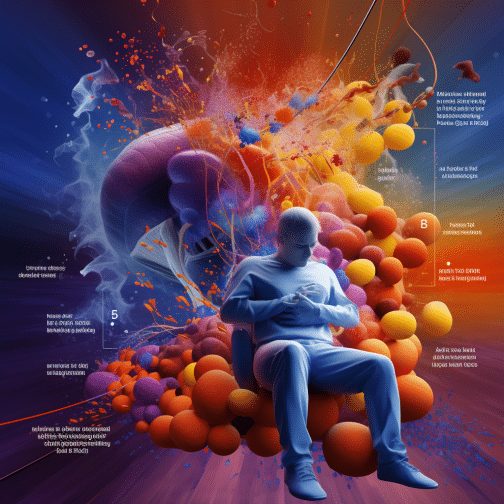6 Stress Reduction Techniques: Anxiety and Low Blood Sugar
 Anxiety and Low Blood Sugar
Anxiety and Low Blood Sugar
Introduction
Living with diabetes can be a stressful experience, especially when it comes to managing low blood sugar levels. Anxiety can be a common side effect of diabetes, and it can be difficult to manage. Fortunately, there are a variety of stress reduction techniques that can help ease anxiety and low blood sugar levels. From mindfulness and meditation to yoga and breathing exercises, these tools can help you stay calm and in control of your diabetes. With the right techniques, you can manage your diabetes and reduce your stress levels.
Understanding Anxiety and Low Blood Sugar
When it comes to managing diabetes, anxiety and low blood sugar can be two of the most difficult challenges to face. Anxiety can be a major source of stress, and low blood sugar can be a dangerous medical condition. It is important to understand the relationship between these two conditions and how to manage them.
Anxiety can be a major factor in the development of low blood sugar. When a person is feeling anxious, their body releases hormones that can cause their blood sugar levels to drop. This can lead to a dangerous situation if not managed properly. It is important to recognize the signs of low blood sugar and take steps to manage it.
On the other hand, low blood sugar can also cause anxiety. When a person’s blood sugar levels drop too low, they may experience symptoms such as dizziness, confusion, and fatigue. These symptoms can be very frightening and can lead to feelings of anxiety. It is important to recognize the signs of low blood sugar and take steps to manage it.
By understanding the relationship between anxiety and low blood sugar, it is possible to take steps to reduce stress and manage diabetes more effectively. Stress reduction techniques such as mindfulness, deep breathing, and yoga can help to reduce anxiety and improve blood sugar control. With the right tools and strategies, it is possible to manage diabetes and reduce stress.

Recognizing the Signs of Low Blood Sugar
Managing diabetes can be a stressful experience, and it’s important to be aware of the signs of low blood sugar. Low blood sugar, or hypoglycemia, can be a dangerous condition if not treated quickly. Symptoms of low blood sugar can include feeling shaky, dizzy, weak, confused, or anxious. If you experience any of these symptoms, it’s important to check your blood sugar levels and take the necessary steps to bring them back to a safe range.
It’s also important to recognize the signs of anxiety that can be associated with low blood sugar. Anxiety can be a normal reaction to the stress of managing diabetes, but it can also be a sign of low blood sugar. If you experience feelings of anxiety, it’s important to check your blood sugar levels and take the necessary steps to bring them back to a safe range.
By recognizing the signs of low blood sugar and anxiety, you can take the necessary steps to reduce stress and keep your diabetes under control. With the right tools and techniques, you can manage your diabetes and reduce your anxiety.

The Link Between Anxiety and Blood Sugar
1. Stress Hormones
When you experience anxiety, your body releases stress hormones like cortisol and adrenaline. These hormones trigger the “fight or flight” response, leading to increased heart rate, rapid breathing, and a surge of energy. To fuel these physiological changes, your body may release stored glucose into the bloodstream, raising blood sugar levels.
2. Increased Insulin Sensitivity
In some cases, chronic anxiety can lead to increased insulin sensitivity. This means that your body becomes more responsive to the insulin it produces, which can lead to a drop in blood sugar levels, particularly if you’re taking insulin or other diabetes medications.
3. Altered Eating Habits
Anxiety can affect eating habits. Some individuals may overeat as a coping mechanism, leading to elevated blood sugar levels. On the other hand, others may skip meals or eat irregularly when anxious, potentially contributing to low blood sugar.
Stress Reduction Techniques for Anxiety and Low Blood Sugar
Managing diabetes can be a stressful experience, especially when it comes to dealing with anxiety and low blood sugar. It’s important to have a few stress reduction techniques in your toolbox to help you cope with these difficult situations.
When it comes to anxiety and low blood sugar, it’s important to take a few moments to pause and take a few deep breaths. This can help to reduce the intensity of the anxiety and give you a moment to think more clearly. Additionally, for anxiety and low blood sugar, engaging in activities such as yoga, meditation, and mindfulness can help to reduce stress and anxiety levels.

When it comes to low blood sugar, it’s important to have a plan in place. Make sure to always have a snack or drink with you that can help to raise your blood sugar levels quickly. Additionally, it’s important to be aware of the signs and symptoms of low blood sugar and to take action quickly if you experience any of them.
By having a few stress reduction techniques in your toolbox, you can be better prepared to manage anxiety and low blood sugar levels. With the right tools, you can feel more confident and in control of your diabetes management.
Managing Anxiety and Low Blood Sugar
1. Mindfulness and Relaxation Techniques
Practicing mindfulness, deep breathing, and relaxation techniques can help reduce anxiety levels. This, in turn, may lower the release of stress hormones and their impact on blood sugar.
2. Consistent Meal Planning
Establish a regular eating schedule with balanced meals and snacks. This can help stabilize blood sugar levels and reduce the risk of hypoglycemia.
3. Medication Management
If you’re taking medications for both anxiety and diabetes, work closely with your healthcare provider to adjust dosages and monitor for potential interactions.
4. Blood Sugar Monitoring
Regularly monitor your blood sugar levels, especially during periods of increased anxiety. This can help you detect and address low blood sugar promptly.
5. Seek Support
Reach out to a mental health professional or support group to address anxiety and develop coping strategies. Managing anxiety effectively can lead to better blood sugar control.
6. Communication
Keep your healthcare team informed about your anxiety symptoms and their impact on your diabetes management. They can tailor your treatment plan accordingly.
The Benefits of Mindfulness and Meditation
Mindfulness and meditation are two powerful tools for reducing stress and anxiety associated with diabetes management. Practicing mindfulness and meditation can help you become more aware of your body and its needs, allowing you to better manage your diabetes.
Mindfulness and meditation can also help you better manage low blood sugar episodes. By focusing on your breath and being mindful of your body, you can become more aware of the signs of low blood sugar and take steps to prevent it from getting worse. Additionally, to anxiety and low blood sugar, mindfulness and meditation can help you stay calm and relaxed during a low blood sugar episode, which can help you better manage the situation.
By incorporating mindfulness and meditation into your diabetes management plan, you can reduce stress and anxiety associated with diabetes and better manage low blood sugar episodes.
Breathing Exercises for Stress Reduction
When it comes to managing diabetes, anxiety and low blood sugar can be two of the most difficult challenges to overcome. Fortunately, there are a number of breathing exercises that can help reduce stress and improve your overall wellbeing.
One of the most effective breathing exercises for reducing anxiety and low blood sugar is diaphragmatic breathing. This technique involves focusing on your breath and taking slow, deep breaths from your diaphragm. This helps to relax your body and mind, allowing you to better manage your diabetes. Additionally, it can help to reduce the physical symptoms of anxiety, such as a racing heart or tightness in the chest.
Another breathing exercise that can help reduce stress and anxiety is alternate nostril breathing. This technique involves alternating between breathing in and out through each nostril, which helps to balance the nervous system and reduce stress. It can also help to reduce the physical symptoms of anxiety, such as a racing heart or tightness in the chest.
By incorporating these breathing exercises into your daily routine, you can help reduce stress and anxiety associated with diabetes management.
Yoga and Exercise for Stress Relief
Yoga and exercise are two of the most effective stress reduction techniques for those managing diabetes. Not only can they help to reduce anxiety, but they can also help to regulate blood sugar levels. Yoga is a great way to relax the body and mind, while also helping to improve flexibility and strength. Exercise can help to reduce anxiety and low blood sugar, stress hormones, while also helping to improve blood sugar control.
Both yoga and exercise can help to reduce the risk of low blood sugar, which can be a major source of anxiety for those with diabetes. By incorporating yoga and exercise into your daily routine, you can help to reduce stress and anxiety, while also improving your overall health.
Creating a Support System for Stress Management
Managing diabetes can be a stressful experience, especially when it comes to dealing with low blood sugar levels. Anxiety can be a common symptom of low blood sugar, and it can be difficult to manage. Fortunately, there are a few strategies that can help you cope with anxiety and low blood sugar.
One of the most important things you can do is to create a support system. Having a network of family and friends who understand your condition can be invaluable. They can provide emotional support and help you stay on track with your diabetes management plan. Additionally, they can help you recognize the signs of low blood sugar and provide assistance if needed.
It’s also important to remember that you don’t have to go through this alone. There are many resources available to help you manage your diabetes and reduce stress. Talking to a healthcare professional or joining a support group can be a great way to get the help and advice you need.
By creating a support system and taking advantage of the resources available, you can better manage your anxiety and low blood sugar levels. With the right tools and strategies, you can reduce stress and take control of your diabetes.
In conclusion, managing stress and anxiety related to diabetes can be a difficult task. However, by understanding the signs of low blood sugar, utilizing stress reduction techniques such as mindfulness and meditation, breathing exercises, yoga and exercise, and creating a support system, individuals can better manage their diabetes and reduce their stress levels. By taking the time to practice these techniques, individuals can gain a better understanding of their diabetes and how to manage it in a healthy and effective way. With the right tools and support, individuals can take control of their diabetes and lead a healthier and happier life.


















